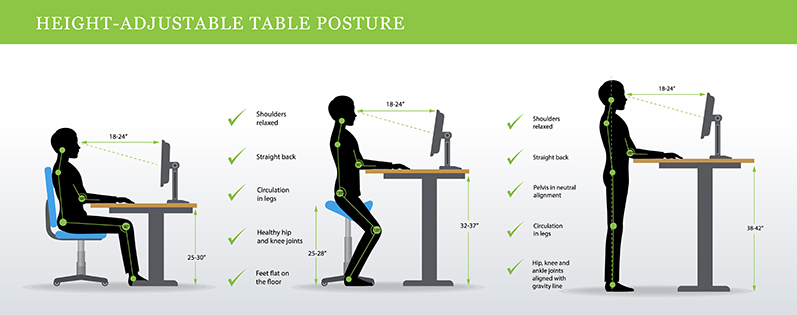Learn more about computer vision syndrome, including its symptoms and prevention

It’s no secret that over the last 15 years screens have become an integral part of our everyday life. Whether it’s our smartphones, computers, or tablets, American adults spend on average about
3 hours on their phones every day—and that’s not including work-related screen use! Most office jobs require people to be on their computers for most of their working days (between 6-8 hours each work day).
This extended exposure to screens, and in particular the
blue light that illuminates them, has brought on many new medical issues like computer vision syndrome (CVS), also known as digital eye strain.
Below, we’ll dive deeper into what computer vision syndrome is and what you need to know about this condition (especially if you get hours of screen time each day!)
What is computer vision syndrome?
Computer vision syndrome describes a range of vision- and eye-related issues that are the result of prolonged screen exposure. Much like carpal tunnel syndrome, CVS is also an injury caused by repetitive motion. When your eyes follow the same path over and over again on your screen, you may start to experience symptoms of CVS.
CVS presents as a number of different symptoms related to eye strain and discomfort. While it is more prevalent in adults who spend the majority of their work day staring at a screen,
children who use tablets and computers during the school day may also have these issues.
What are the causes of computer vision syndrome?
When you’re looking at a computer or digital screen for a prolonged period, the eyes work harder than usual. As a result, individuals become susceptible to the development of vision-related issues like computer vision syndrome.
Viewing a computer or digital screen is different than reading a printed page. Often the letters on the computer or handheld device are not as precise or sharply defined, the level of contrast of the letters to the background is reduced, and the presence of glare and reflections on the screen may make viewing difficult.
When you work at a computer, your eyes have to focus and refocus all the time. They move back and forth as you read. You may have to look down at papers and then back up to type. Your eyes react to images constantly moving and changing, shifting focus, sending rapidly varying images to the brain.
All these actions require maximum effort from your eye muscles. And to make things worse, unlike a book or piece of paper, the screen adds contrast, flicker, and glare.
You’re more likely to have CVS issues if you already have eye trouble, if you need glasses but don't have them, or if you wear the wrong prescription for computer use. Working (and staring) at the computer gets harder as you age and the natural lenses in your eyes become less flexible. As you get older your ability to focus on near and far objects will begin to become increasingly more difficult.
Some of the main causes of computer vision syndrome are:
- Glare for a digital screen
- Poor lighting
- Uncorrected vision problems
- Improper viewing distances
- Poor posture while seated
- Any combination of these factors
In most cases, symptoms of CVS occur because the visual demands of the task exceed the visual abilities of the individual to comfortably perform them. People who spend more than two hours at a time at a computer are more susceptible to this condition as well.
Computer vision syndrome symptoms
Currently, there isn’t enough data to prove that computer use causes long-term eye damage, but computer vision syndrome symptoms commonly appear as:
- Dryness or redness of eyes
- Eye irritation
- Tearing
- Eye fatigue
- Double vision
- Blurred vision
- Neck or back pain
- Headaches
- Vertigo or dizziness
The extent to which individuals experience visual symptoms often depends on the level of their visual abilities and the amount of time spent looking at a screen. Uncorrected vision problems like farsightedness and astigmatism, inadequate eye focusing or eye coordination abilities, and aging changes of the eyes, such as
presbyopia, can all contribute to the development of visual symptoms when using a computer or device with a screen.
Many of the visual symptoms experienced by users are only temporary and will decline after stopping computer work or use of the digital device. However, some individuals may experience continued reduced visual issues, such as blurred distance vision, even after stopping work at a computer.
If nothing is done to address the cause of the problem, the symptoms will continue to recur and perhaps worsen with future digital screen use.
How is computer vision syndrome diagnosed?
An eye care provider can make a diagnosis by looking at your health history and administering a complete eye exam. During the exam, your optometrist may review the following:
- Patient history - Helps determine any symptoms the patient is experiencing and the presence of any general health problems, medications taken or environmental factors that may be contributing to the symptoms related to computer use.
- Visual acuity measurements - Allows them to assess the extent to which vision may be affected.
- Refraction test - Helps determine the appropriate lens power needed to compensate for any refractive errors (nearsightedness, farsightedness or astigmatism).
- Testing how the eyes focus, move and work together - Allows them to look for problems that keep the eyes from focusing effectively or make it difficult to use both eyes together.
Your optometrist can assess if there are any factors aside from computer use that are causing the eye issues. Using the information they gather from these tests, along with the results of other tests, your eyecare professional can determine the presence of CVS and advise treatment options.
What are the treatments for computer vision syndrome?
Some of the most common ways to treat CVS are as follows:
- Rest your eyes at least 15 minutes after each 2 hours of computer or digital device use.
- Every 20 minutes, look into the distance at least 20 feet away from the computer or digital device. Do this for at least 20 seconds.
- Enlarge the text on your computer screen or digital device.
- Minimize glare from the light sources in your environment.
- Think about using a screen glare filter.
- Place your screen so that the center of it is about 4 to 5 inches below eye level (about 15 to 20 degrees from the horizontal).
- Place your screen about 20 to 28 inches from your eye.
- Remember to blink often.
- Fix your chair height so your feet can rest comfortably on the floor.
- Don’t slump over the computer screen.
These changes can help in alleviating the symptoms of CVS. For most people, they can help get rid of the symptoms completely. If your eye care provider has found any underlying hidden health problems that may be causing your computer vision syndrome, they might prescribe something to help.
For example, you might need a new pair of glasses. Your eye care provider might also prescribe lubricating eye drops or a prescription medication to increase tear production. Creating a more humid work environment, drinking more fluids, and treating allergies can also help reduce symptoms.
How to prevent computer vision syndrome
As office work life continues to impact our health, there have been major advances in ergonomics. Practicing ergonomics in your work environment is a great way to prevent computer vision syndrome. One thing in particular that has been shown to help prevent the symptoms is
sitting and standing properly at your desk.

Some important factors in preventing or reducing the symptoms of CVS have to do with the computer and how it’s used. This includes lighting conditions, chair comfort, location of reference materials, the position of the monitor, and the use of rest breaks.
Here are some quick tips for preventing CVS:
Adjust your computer screen.
Your computer screen should be 15 to 20 degrees below eye level (about 4 or 5 inches). It should also be about 20 to 28 inches from the eyes to the center of the screen.
Arrange your desk properly.
When using reference materials or taking notes, you should keep any materials above the keyboard and below the monitor. If that’s not possible, a document holder can be used beside your monitor.
The goal is to position the documents so that your head doesn’t need to be repositioned from the document to the screen. (Remember, repetitive motion is what causes CVS!)
Cut the glare.
Change the lighting around you to reduce the effect of glare on your computer screen. If light from a nearby window casts a glare, move your monitor and close the shades.
Ask your employer to install a dimmer switch for the overhead fixtures if they're too bright, or buy a desk lamp with a moveable shade that casts light evenly over your desk. You can also add a glare filter to your monitor.
Give your eyes a break.
Follow the 20-20-20 rule. Although this can be used as a treatment as we read earlier, doing this before having symptoms can prevent CVS from happening to you in the first place.
Here’s a refresher on the 20-20-20 rule: Look away from the screen every 20 minutes or so and look at something around 20 feet away for about 20 seconds.
Tweak your computer settings.
You don't have to use your computer with the factory-installed presets if you're uncomfortable. Adjust the brightness, contrast, and font size until you find what’s best for you.
While it’s nearly impossible to avoid screens, especially for work, you can take the steps above to prevent computer vision syndrome or at least help keep the symptoms to a minimum. If you have children that are using a tablet or laptop for school, it is a good idea to keep this in mind for them as well.
 For more information about Germania's insurance products, request a free quote online, or reach out to your local Germania Authorized Agent today!
For more information about Germania's insurance products, request a free quote online, or reach out to your local Germania Authorized Agent today!